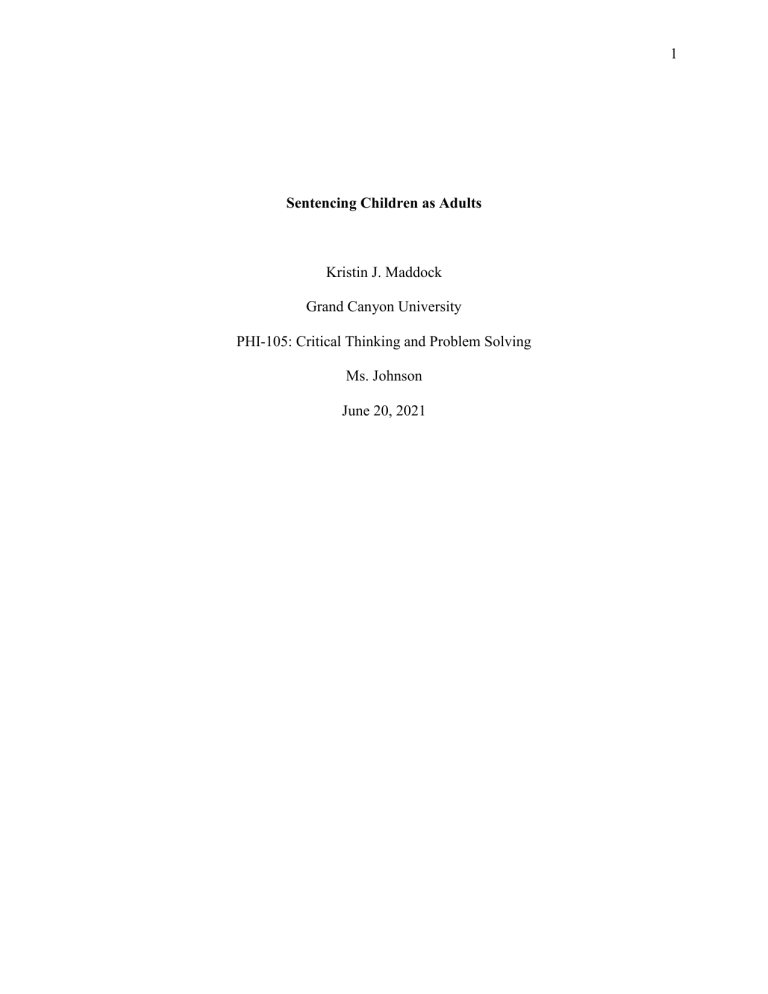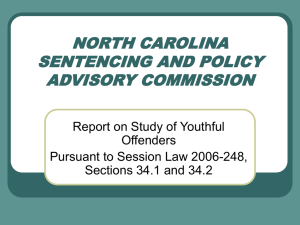
1 Sentencing Children as Adults Kristin J. Maddock Grand Canyon University PHI-105: Critical Thinking and Problem Solving Ms. Johnson June 20, 2021 2 Sentencing Children as Adults Old enough to do the crime, old enough to do the time”, seems to be the outlook of many within today’s justice system. And sadly, this point of view has ruined and will continue to ruin the lives of many youths. Each year in the U.S., 250,000 young teens are sent through the adult judicial system. This movement stems from the serious crimes (drugs, robberies, rapes, and murder) committed by teens in the late 80s and 90s. In 1996, criminalist John Delulio presented President Clinton with his opinion on why juvenile violence was increasing. He described these super-predator teens as having no empathy and without conscience, capable of the most heinous acts, and will do what is natural to them: assault, rob, burglarize, rape, and murder (Drum, 2016). This justification was used to push thru a law that would make it acceptable to lock minors away with dangerous adult criminals; criminals that are responsible for bullying, assaulting, and victimizing many juveniles sentenced to the same prison. Thus, it is crucial to stop sentencing child offenders to adult prisons because their mental development and consciousness about the crime are not that of an adult's, the effects of adult prison are devastating and destructive to the juvenile, and it increases their likelihood of reoffending in the future. Sentencing a juvenile as an adult is morally and ethically wrong since their mental development and consciousness about the crime differ from that of an adult due to their underdeveloped brain. Research tells us that adult and teenaged brains function differently. Adults use the prefrontal cortex, the reasoning portion of the brain that acts with good judgment and understanding of long-term consequences; teenagers process information with the amygdala, the emotional part (Campellone MD & Turley BSN MSN RN, n.d.). The prefrontal cortex is located in the frontal lobe -- the part of the brain that controls impulses, problem solving, judgment, and planning and executing movements. This part of the brain does not fully develop 3 until a person reaches their early twenties (Burke, 2011). Adolescents go through significant psychological and cognitive change and development, which impacts their ability to react appropriately to certain situations (Castro, Muhammad, & Arthur, 2014). And teenagers have less experience and development than adults, therefore bear less responsibility for their actions than adults who commit similar acts (Burke, 2011). Although intellectually equivalent to adults, adolescents are more inclined to act impulsively, be influenced by others, and engage in dangerous experimentation. Trying minors as adults and subsequently imprisoning them, in adult facilities with grown criminals, can result in very devastating and destructive effects. Of the forty-four state prisons that can house juveniles in the United States, only 18 have the means to house them separately (Levitt, 2011). According to research, adolescents in adult institutions are five times more likely to be sexually assaulted and two times more likely to be beaten by employees than in juvenile institutions (Castro, E., Muhammad, D., & Arthur, P. (2014). And teens in adult prisons are 50% more likely to be assaulted with a weapon (Heller et al., 2017). When we integrate teenagers with adult criminals, the likelihood that they are subjected to intense violence, become abused, and suffer from disease is much greater. They also lack sufficient resources to help them with their mental health, education, and rehabilitation. (Heller et al., 2017). Moreover, adult jails and prisons expose adolescents to the very dangers that the law protects them from, which constitutes a violation of the eighth amendment since they are illegal in the eyes of the law. Studies agree that putting minors through the adult judicial system does not reduce recidivism; rather, it encourages criminal behavior. In a study exploring recidivism, using 59 juveniles serving adult time for murder or attempted murder, the results showed that 90% of 4 these released juvenile offenders have been re-arrested and half of them for more than one violent crime. Approximately 35% committed four or more violent crimes (Heide, Hummel, Ingraham, Khachatryan, & Rad, 2016). Punishing children with adult-size consequences does not make the community safer. Evidence shows that it has a negative impact on public safety. Recidivism is higher among youths sentenced in adult courts than among those charged in juvenile courts. (Castro, E., Muhammad, D., & Arthur, P. (2014). “Research consistently finds that treating youthful offenders as adults is inappropriate, detrimental to their development, and ineffective as a deterrent to crime.” (Castro, Muhammad, & Arthur, 2014 p. 2). And when they are released, the flaws of the system and their experiences within it make it impossible for them to blend in and live normal lives. Consequently, they fall back into old habits or worse, which could cost them their freedom and land them back in prison. It is crucial to stop sentencing child offenders to adult prisons because their mental development and their consciousness about the crime is not that of an adult's, the effects of adult prison are devastating and destructive, and it increases their likelihood of reoffending in the future. In today's court system, prosecuting kids as adults is a failure. The system perpetuates a cycle of violence and injury among society's youngest and least privileged members, with little opportunity for rehabilitation or forgiveness. Sending juveniles to adult courts is wrong because it not only exposes them to all kinds of pain and abuse, but it also increases the risk of recidivism and the system fails to warn society about the human beings they have produced as a result of this process. Sentencing juveniles as if they were adults have to stop. It is morally and ethically wrong. Juveniles should never have to be subjected to the adult legal system. 5 References Burke, A. S. (2011). Under construction: Brain formation, culpability, and the criminal justice system. International Journal of Law and Psychiatry, 34(6), 381–385. https://doiorg.lopes.idm.oclc.org/10.1016/j.ijlp.2011.10.001 Campellone MD, J., & Turley BSN MSN RN, R. K. (n.d.). Understanding the Teen Brain Health Encyclopedia - University of Rochester Medical Center. University of Rochester Medical Center. Retrieved June 7, 2021, from https://www.urmc.rochester.edu/encyclopedia/content.aspx?ContentTypeID=1&ContentI D=3051 Castro, E., Muhammad, D., & Arthur, P. (2014). Treat Kids as Kids - Why Youth Should Be Kept in the Juvenile System. California Alliance Youth & Community Justice. http://caycj.org/documents/TreatKidsasKids.pdf Drum, K. (2016, March 3). A very brief history of super-predators. Mother Jones. https://www.motherjones.com/kevin-drum/2016/03/very-brief-history-super-predators/ Heide, K. M., Hummel, E. V., Ingraham, M., Khachatryan, N., & Rad, J. (2016). Examination of long-term post release outcomes of juvenile homicide offenders. Journal of Offender Rehabilitation, 55(8), 503–524. https://doiorg.lopes.idm.oclc.org/10.1080/10509674.2016.1229711 Heller, J., Human Impact Partners, Ortenburger, M., Santiago, F., Tellez, A., & Heller, J. (2017, February). Juvenile Injustice: Charging Youth as Adults is Ineffective, Biased, and Harmful. Ranil Abeysekera, Community Printers. https://humanimpact.org/wpcontent/uploads/2018/10/HIP_JuvenileInJusticeReport_2017.02.pdf 6 Levitt, L. (2011). The comparative risk of mistreatment for juveniles in detention facilities and state prisons. The International Journal of Forensic Mental Health, 9(1), 44–54. https://doi-org.lopes.idm.oclc.org/10.1080/14999013.2010.483344

